Why Do Employees Leave?
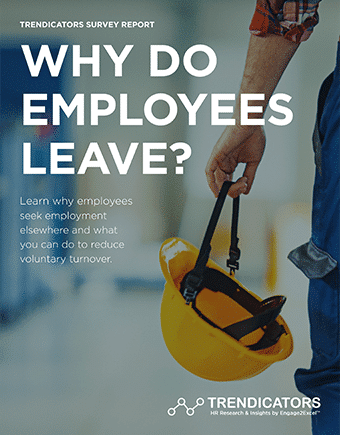
The Current Retention Challenge
25% of employees will leave their jobs in 2018*
77% of that turnover could be prevented by employers*
WHAT CAN HR LEADERS DO TO STEM THE TIDE OF VOLUNTARY TURNOVER?
This eBook analyzes results from a survey of 5,000 U.S. employees and presents practical ideas for improving retention that are
easy and inexpensive to implement.
*SOURCE: Work Institute 2018 Retention Report
Download
 hbspt.cta.load(123973, '55694786-c4e6-4dfa-84b9-780f90a46d91', {});
hbspt.cta.load(123973, '55694786-c4e6-4dfa-84b9-780f90a46d91', {});
INTRODUCTION
Our nationwide survey reveals why employees leave and what you can do about it.
Due to ever-increasing competition for top talent, employee retention has become a business-critical concern across all major industries. As the economy continues to perform well and the unemployment rate continues to decline, HR leaders need to understand the current drivers of employee turnover in order to improve the effectiveness of their retention initiatives.
To provide new, science-driven insights about why employees leave, the Trendicators research division of Engage2Excel conducted a regression analysis of data collected via our nationwide survey of 5,000 U.S. employees representing all major industry sectors and demographic groups. Our objective was to shed new light on the attitudes and perceptions of employees who responded affirmatively to the statement, “I am seriously considering leaving my organization in the next 12 months.”
The findings presented in this report address four key questions:
- What are the top drivers of employee turnover in 2018?
- What are the greatest differences between employees who intend to stay and leave?
- How do turnover-intention levels differ between generations?
- Which industry sectors face the highest and lowest turnover risk in 2018?
Survey Demographics
Number of Respondents: 5,000
Countries Represented: United States
Industries Represented: All major industries
Respondent Demographics: U.S. adult workers in all job types with proportionate representation of gender, age group and racial/ethnic origin
Margin of Error: 95% confidence level; +/- 1.5%
In addition to presenting an analysis of the survey results, this report also presents recommendations for overcoming negative perceptions of employees who intend to leave along with ideas for building more robust, engaging and effective retention programs.
“Why Do Employees Leave?” is the result of research and analysis conducted by Engage2Excel’s chief scientific officer, Jack Wiley, Ph.D. As an internationally recognized author, consultant, researcher and instructor, Dr. Wiley has spent over three decades focusing on two big research questions: what employees most want and which organizational factors best promote employee engagement, performance confidence and business success.
Download
 hbspt.cta.load(123973, '55694786-c4e6-4dfa-84b9-780f90a46d91', {});
hbspt.cta.load(123973, '55694786-c4e6-4dfa-84b9-780f90a46d91', {});
REGRESSION ANALYSIS
What are the top drivers for intent to leave in 2018?
In order to understand employee intent to leave, we conducted a regression analysis of data from our nationwide survey of U.S. employees. This analysis revealed six survey items, listed in the table below, which had the greatest influence on an employee’s response to the statement, “I am seriously considering leaving my organization in the next 12 months.”
The left-hand column lists the topical category of each survey item. The far-right column shows the four top drivers for turnover intent in 2018. Our analysis reveals that the organizations best suited to retain employees are effective at pay for performance, creating a sense of confidence in the organization’s future, ensuring employees feel a sense of career development opportunity, and making sure that employees are satisfied with the recognition they get for the work they do.
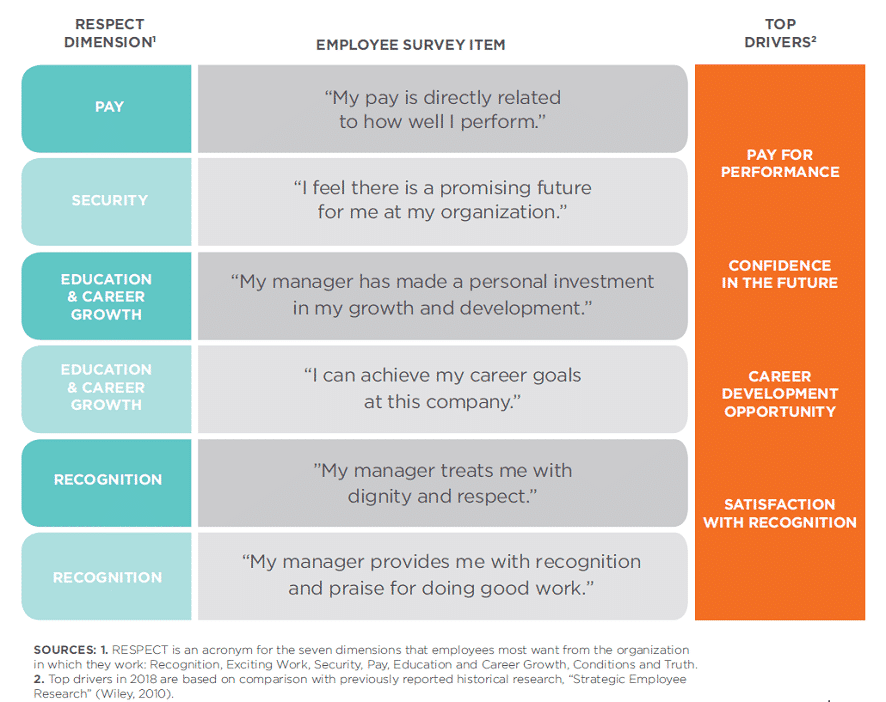
Download
 hbspt.cta.load(123973, '55694786-c4e6-4dfa-84b9-780f90a46d91', {});
hbspt.cta.load(123973, '55694786-c4e6-4dfa-84b9-780f90a46d91', {});
GAP ANALYSIS
What are the greatest differences between employees who intend to stay and leave?
Of the six drivers for turnover-intention, four are, practically speaking, the same for employees who intend to leave and those who intend to stay. The two items where the sub-samples most differ are: “My pay is directly related to how well I perform” and, “My manager has made a personal investment in my growth and development.” This suggests that the organizations doing a better job of retaining staff are those who attend to issues of fair compensation and whose managers are involved in the growth and development of subordinate employees. Fair compensation as a retention issue in 2018 would correlate with the employee-centric job market and the current rise in pay levels.
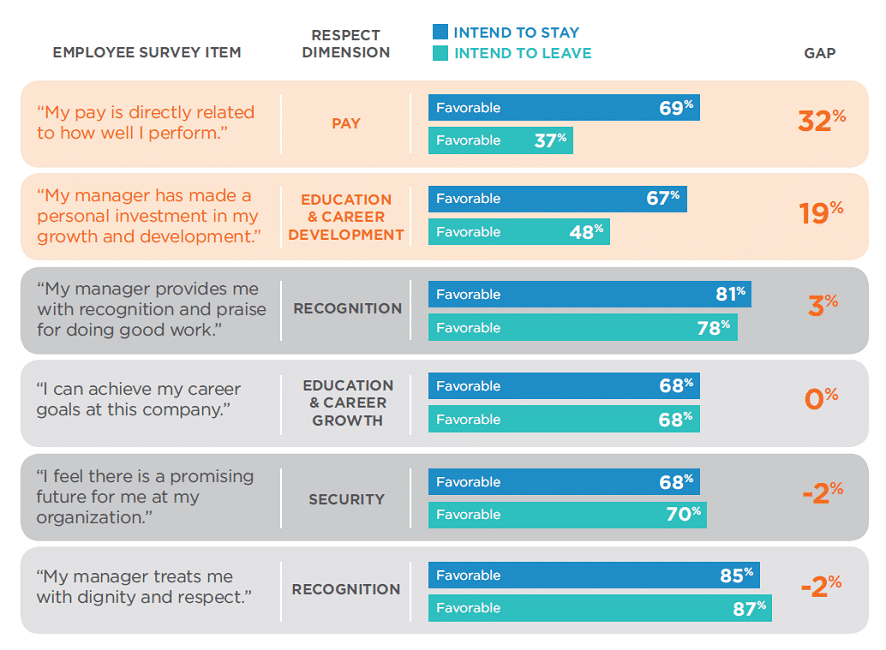
Download
 hbspt.cta.load(123973, '55694786-c4e6-4dfa-84b9-780f90a46d91', {});
hbspt.cta.load(123973, '55694786-c4e6-4dfa-84b9-780f90a46d91', {});
GENERATIONAL DIFFERENCES
How do turnover-intention levels differ between generations?
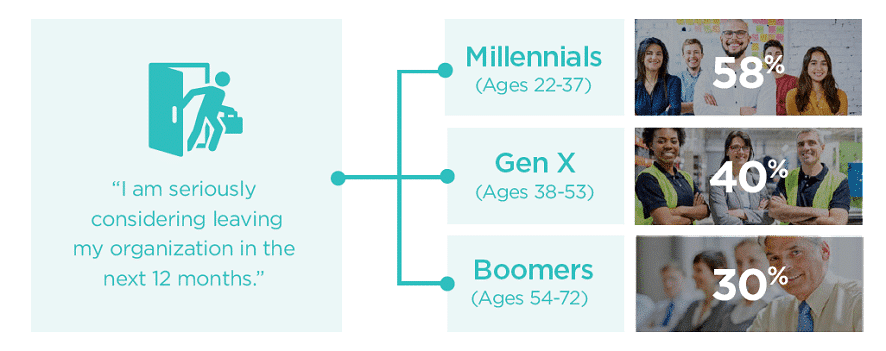
INDUSTRY ANALYSIS
Which industry sectors face the highest and lowest turnover risk in 2018?
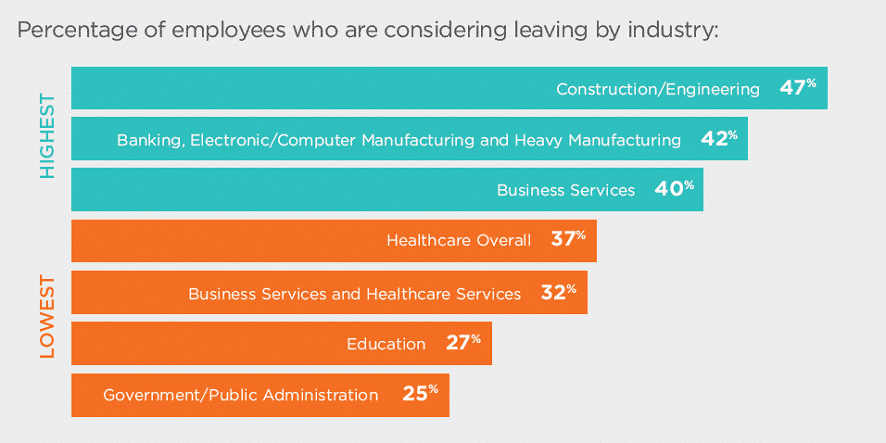
Download
 hbspt.cta.load(123973, '55694786-c4e6-4dfa-84b9-780f90a46d91', {});
hbspt.cta.load(123973, '55694786-c4e6-4dfa-84b9-780f90a46d91', {});
RECOMMENDATIONS
How can you overcome the negative perceptions of employees who intend to leave?
Depending on your industry, the percentage of employees who are seriously considering leaving in the next 12 months ranges from 25% to 47%, and this percentage is highest (58%) among millennials. The following are practical recommendations for what you can do to address the negative perceptions that have the greatest influence on employees who intend to leave.
PAY: “My pay is directly related to how well I perform.”
Find out what fair pay means: Discover what your employee is expecting in terms of pay and what he/she believes constitutes fair pay. This one-to-one discussion will help clear up misconceptions.
Understand what rewards your employee values: Tailor rewards to employee preferences. Remember that consistent recognition and praise can be a great alternative to monetary rewards.
Link pay and rewards to performance: Employees should easily be able to see how their effort, performance and rewards are linked. Linking pay to performance for employees creates a greater sense of responsibility, job ownership and control over their pay and rewards.
EDUCATION & CAREER GROWTH: “My manager has made a personal investment in my growth and development.”
Make a personal investment: Employees want to feel that you are personally invested. Sit down and create an individualized development plan.
Offer flexible opportunities: Ensure that engaging in career development opportunities doesn’t leave your employee feeling overwhelmed. Consider less time-restricted opportunities such as mentoring, job shadowing and mobile learning opportunities.
Tailor training and development opportunities: Each employee has a different set of knowledge, skills and abilities; therefore, a
one-size-fits-all approach may not work.
How can you build a more robust, engaging and effective retention program?
The recommendations on the previous page address the drivers that most influence the stay-leave decision. However, our turnover-intention analysis also reveals that organizations best suited to retain employees excel at: making sure employees are satisfied with the recognition they receive for the work they do, ensuring that employees feel a sense of career development opportunity, enabling employees to feel they have a promising future and treating employees with dignity and respect. Consider the following recommendations for creating a more robust, engaging and effective employee retention program.
RECOGNITION: “My manager provides me with recognition and praise for doing good work.”
Tie recognition to business objectives: Linking recognition to the organization’s strategy and goals helps employees know exactly how they are contributing to the organization’s long-term success. For example, if an organization-wide goal is to increase overall customer satisfaction, reward employees when you see them exhibiting outstanding service to a customer.
Celebrate the big and small wins: Celebrations function as prime motivators and rewards, expressing that the organization places a high level of importance on employee involvement in meeting goals. When only focusing on big wins, recognition can be too infrequent. To keep employees engaged, it is important to pinpoint and recognize small wins along the way.
EDUCATION & CAREER GROWTH: “I can achieve my career goals at this company.”
Ask employees what they need: Regularly soliciting ideas for the development of your employees can help you understand what they want and give you fresh, new ideas. There are two useful questions to ask your employees: 1) What skills are you looking to develop? and 2) How can I help you grow?
Incorporate growth opportunities into the strategic plan: Opportunities for training and development should be considered
in both the organization’s and department’s strategic plans. Incorporating these opportunities sets the stage for the budgetary and time considerations needed to effectively provide training opportunities.
SECURITY: “I feel there is a promising future for me at my organization.”
Investigate what employees want from their job: Frequently talk with employees and discuss what they want from their jobs regarding long-term employment and career development. Discussing the future can help instill a sense of security and confidence in the organization.
Become acquainted with employees: Get to know your employees on a personal level. Ask about their hobbies outside of work or other personal preferences. Being interested in your employees’ personal lives can demonstrate that you are committed.
Inform employees of current and future opportunities: If an organization’s managers and leaders make it clear that gaining skills and experience is likely to result in continued employment, employees are likely to behave in ways that lead to the desired result. Because of this, it is important to keep employees aware of opportunities that may help them gain these worthwhile skills.
RECOGNITION: “My manager treats me with dignity and respect.”
Treat all employees with respect: Treat all employees, no matter their differences (e.g., race, gender, age, religion, sexual orientation), with dignity and respect. Implement policies and procedures consistently so employees feel they are treated fairly and equally. Perceived inconsistency of the recognition system may demotivate employees.
Ensure each employee knows his or her importance: Employees want to feel as though the organization appreciates both their work and well-being. Emphasize to your employees how their individual work contributes to the organization as a whole.
Initiate a formal length-of-service program: Found in over 75% of organizations, these programs are most favored by millennials. Leaders can demonstrate recognition of tenure by acknowledging employees’ accomplishments throughout their time in the organization and celebrating work anniversaries and milestones. Be sure to start these programs early in the employment journey during the onboarding phase.
Download
 hbspt.cta.load(123973, '55694786-c4e6-4dfa-84b9-780f90a46d91', {});
hbspt.cta.load(123973, '55694786-c4e6-4dfa-84b9-780f90a46d91', {});